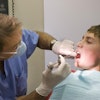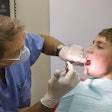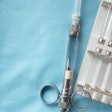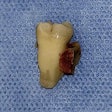
Using computerized anesthesia devices results in less pain and anxiety for adult dental patients compared to traditional anesthesia delivery, according to a review article published online in the Journal of Oral and Maxillofacial Surgery.
However, the authors stopped short of encouraging dentists to drop conventional anesthesia methods and invest in computerized local anesthesia devices (CLADs), partly due to high costs and learning curves associated with CLAD systems.
"We do not consider investing in a CLAD with the objective of reducing pain and anxiety related to local anesthesia as a primary factor because of the greater cost, logistics, and learning time for its management by the operator," wrote the group, led by Dr. Arthur José Barbosa de França of the department of oral and maxillofacial surgery at the University of Pernambuco in Recife, Brazil (J Oral Maxillofac Surg, November 28, 2021).
Noting that "conventional anesthesia is widely used, safe, and effective," the authors posited that traditional anesthesia techniques can produce the same clinical results as CLAD, but without the learning costs.
"Conventional injection can yield similar clinical results, in addition to being less expensive and easier to handle and learn," de França et al wrote.
Computerized anesthesia devices deliver big results
The authors' review included 10 studies performing systematic comparison between conventional anesthesia and CLAD. The results showed that the "CLAD group demonstrated better results, both in pain reduction during injection and in improvement in the effectiveness of anesthesia during treatment," they wrote.
All 10 of the surveyed studies recorded lower pain scores for CLAD compared to conventional delivery across all four treatment phases: during needle insertion, during injection/deposition, after injection, and during the procedure. CLAD also yielded superior results in terms of rated anxiety, patient preference, and speed of anesthetic administration.
To carry out the evaluation, two of the authors assessed the 10 studies following the Grading of Recommendations Assessment, Development and Evaluation (GRADE) system, which classifies the quality of a study's evidence as low, medium, or high, based on a confluence of factors, including the study's design and risk of bias in reported outcomes. In cases of disagreement, a third author made the final decision.
Of the 10 studies, nine were randomized controlled trials and one was a nonrandomized controlled clinical trial. The assessment measured pain in adult dental patients during the insertion of the needle, injection or deposition of the anesthetic, after the injection, and during the procedure. In total, 506 patients were evaluated.
The authors cautioned against drawing firm conclusions from the studies due to the wide differences among them. These differences included variations in dental procedures, local anesthetics (2% lidocaine, 4% articaine, or 3% mepivacaine), dosage volumes, and the site of intraoral anesthesia.
"Caution should be exercised when interpreting these results due to differences in assessment methods," they wrote.
Looking to the future, the authors recommended that differences in the assessment methods be standardized to improve their applicability.
"Due to the heterogeneity among studies, we strongly recommend that new RCTs [randomized controlled trials] be performed using well-defined methodologies to improve the quality of evidence regarding this topic," they concluded.



















